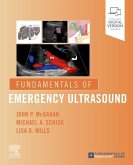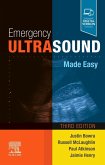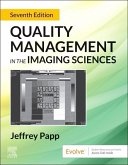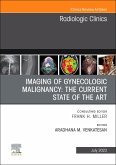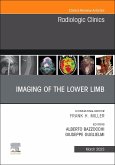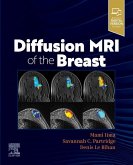Multiparametric Ultrasound for the Assessment of Diffuse Liver Disease
A Practical Approach
Herausgeber: Ferraioli, Giovanna; Barr, Richard G.
Multiparametric Ultrasound for the Assessment of Diffuse Liver Disease
A Practical Approach
Herausgeber: Ferraioli, Giovanna; Barr, Richard G.
- Broschiertes Buch
- Merkliste
- Auf die Merkliste
- Bewerten Bewerten
- Teilen
- Produkt teilen
- Produkterinnerung
- Produkterinnerung
For those who treat and diagnose liver disease, whether radiologists, emergency medical physicians, hepatologists, or sonographers, a clear understanding of the strict protocol needed to obtain accurate measurements is essential. Multiparametric Ultrasound for the Assessment of Diffuse Liver Disease offers a practical approach to liver shear wave elastography acquisition from globally recognized leaders in the field. It answers critical questions such as how to use each of the current techniques to best characterize your patients' liver disease, how to deal with the limitations of each of…mehr
Andere Kunden interessierten sich auch für
![Fundamentals of Emergency Ultrasound Fundamentals of Emergency Ultrasound]() John P. McGahan (University of California Department of RadiologyFundamentals of Emergency Ultrasound125,99 €
John P. McGahan (University of California Department of RadiologyFundamentals of Emergency Ultrasound125,99 €![Emergency Ultrasound Made Easy Emergency Ultrasound Made Easy]() Emergency Ultrasound Made Easy47,99 €
Emergency Ultrasound Made Easy47,99 €![Practical Ultrasound Practical Ultrasound]() Jane AltyPractical Ultrasound94,99 €
Jane AltyPractical Ultrasound94,99 €![Quality Management in the Imaging Sciences Quality Management in the Imaging Sciences]() Jeffrey Papp (Professor of Physics and College Diagnostic ImagingQuality Management in the Imaging Sciences90,99 €
Jeffrey Papp (Professor of Physics and College Diagnostic ImagingQuality Management in the Imaging Sciences90,99 €![Imaging of Gynecologic Malignancy: The Current State of the Art, An Issue of Radiologic Clinics of North America Imaging of Gynecologic Malignancy: The Current State of the Art, An Issue of Radiologic Clinics of North America]() Imaging of Gynecologic Malignancy: The Current State of the Art, An Issue of Radiologic Clinics of North America130,99 €
Imaging of Gynecologic Malignancy: The Current State of the Art, An Issue of Radiologic Clinics of North America130,99 €![Imaging of the Lower Limb, An Issue of Radiologic Clinics of North America Imaging of the Lower Limb, An Issue of Radiologic Clinics of North America]() Imaging of the Lower Limb, An Issue of Radiologic Clinics of North America128,99 €
Imaging of the Lower Limb, An Issue of Radiologic Clinics of North America128,99 €![Diffusion MRI of the Breast Diffusion MRI of the Breast]() Diffusion MRI of the Breast120,99 €
Diffusion MRI of the Breast120,99 €-
-
-
For those who treat and diagnose liver disease, whether radiologists, emergency medical physicians, hepatologists, or sonographers, a clear understanding of the strict protocol needed to obtain accurate measurements is essential. Multiparametric Ultrasound for the Assessment of Diffuse Liver Disease offers a practical approach to liver shear wave elastography acquisition from globally recognized leaders in the field. It answers critical questions such as how to use each of the current techniques to best characterize your patients' liver disease, how to deal with the limitations of each of these techniques, and what to ask-and not to ask-of your devices and software. Presents an overview of conventional ultrasound findings in chronic liver disease and portal hypertension, and presents the basic concepts and protocols needed to measure liver stiffness and interpret liver stiffness values. Details clinical applications, artifacts, and guidelines of liver ultrasound elastography, including tips and tricks. Reviews the latest ultrasound techniques to assess liver steatosis and focal liver lesions, as well as the uses of new technologies of fat quantification and dispersion. An eBook version is included with purchase. The eBook allows you to access all of the text, figures and references, with the ability to search, customize your content, make notes and highlights, and have content read aloud.
Hinweis: Dieser Artikel kann nur an eine deutsche Lieferadresse ausgeliefert werden.
Hinweis: Dieser Artikel kann nur an eine deutsche Lieferadresse ausgeliefert werden.
Produktdetails
- Produktdetails
- Verlag: Elsevier - Health Sciences Division
- Seitenzahl: 256
- Erscheinungstermin: 8. November 2022
- Englisch
- Abmessung: 153mm x 234mm x 12mm
- Gewicht: 424g
- ISBN-13: 9780323874793
- ISBN-10: 0323874797
- Artikelnr.: 65177708
- Herstellerkennzeichnung
- Libri GmbH
- Europaallee 1
- 36244 Bad Hersfeld
- gpsr@libri.de
- Verlag: Elsevier - Health Sciences Division
- Seitenzahl: 256
- Erscheinungstermin: 8. November 2022
- Englisch
- Abmessung: 153mm x 234mm x 12mm
- Gewicht: 424g
- ISBN-13: 9780323874793
- ISBN-10: 0323874797
- Artikelnr.: 65177708
- Herstellerkennzeichnung
- Libri GmbH
- Europaallee 1
- 36244 Bad Hersfeld
- gpsr@libri.de
1. Introduction (basics of chronic liver disease - incidence, etc.)
Guadalupe Garcia-Tsao (Yale University School of Medicine, CT, USA)
Chronic liver disease is a substantial world-wide problem. It can be due to
a wide range of etiologic agents. Any process that leads to chronic
inflammation can progress to chronic liver disease. Its major consequence
is increasing deposition of fibrous tissue within the liver leading to
cirrhosis with its complications, such as portal hypertension, hepatic
insufficiency and hepatocellular carcinoma.
Key words: chronic liver disease, liver fibrosis, shear wave elastography,
hepatitis B, hepatitis C, NAFLD, NASH.
2. Liver stiffness measurement techniques basics
Giovanna Ferraioli, Mark L Palmeri (Duke University, NC, USA), Richard G
Barr
Liver elastography can be performed with various techniques. These include
both ultrasound-based elastography and magnetic resonance elastography. The
ultrasound methods include strain elastography (SE), VCTE, and ARFI
techniques (pSWE and 2D-SWE). SE is limited in evaluation of liver
stiffness and will not be presented in this book.
Key words: VCTE, pSWE, 2D-SWE, ARFI, shear wave elastography, MRE,
vibration elastography, phantom studies.
a. TE
b. ARFI techniques
c. MRE
d. Vibratory Techniques
3. Protocol for acquisition
Giovanna Ferraioli, Richard G Barr
For all of the ultrasound techniques (vibration-controlled transient
elastography, point shear wave elastography and two-dimensional shear wave
elastography) the patient is studied in the supine or slight left lateral
decubitus position. The protocol for a correct acquisition will be
presented in details.
Key words: VCTE, pSWE, 2D-SWE, ARFI, shear wave elastography, liver
stiffness.
a. General protocol
b. Quality Assessment
i. Vendor specific quality assessment
4. Tips and Tricks
Giovanna Ferraioli, Richard Barr
For a reliable acquisition, several factors should be taken into account.
They include depth for measurement, presence of liver steatosis, transducer
frequency, transducer position, number of measurements, confounders and so
on. All these factors will be analyzed in details.
Key words: reliability, accuracy studies.
5. Artifacts
Giovanna Ferraioli, Mark Palmeri (Duke University, NC, USA), Richard G Barr
Identification of the artifacts is of outmost importance for the
interpretation. Knowing them is also important for acquiring the best
images for accurate diagnosis.
Key words: reverberation, attenuation, failure, phantoms studies.
a. TE
b. ARFI techniques
c. MRE
6. Staging liver fibrosis with shear wave elastography
Giovanna Ferraioli, Davide Roccarina (Careggi University Hospital,
Florence, Italy), Jonathan Dillman (University of Cincinnati College of
Medicine, OH, USA), Richard G Barr
As of today, shear wave elastography has been accepted as a reliable
substitute of liver biopsy in several clinical scenarios, mainly in
patients with viral etiologies and/or NAFLD/NASH. The role of shear wave
elastography in several etiologies of liver disease and in the pediatric
population will be presented.
Key words: liver stiffness, hepatitis B, hepatitis C, NAFLD, NASH, primary
sclerosing cholangitis, autoimmune hepatitis, alcoholic hepatitis, cystic
fibrosis, biliary atresia, Fontan circulation, children.
a. Viral etiologies
b. NAFLD/NASH
c. Other etiologies
d. Pediatrics
7. Portal hypertension: liver and spleen stiffness
Davide Roccarina (Careggi University Hospital, Florence, Italy)
Liver stiffness correlates with the severity of liver fibrosis up to the
threshold of clinically significant portal hypertension. At this stage, the
strength of the correlation between liver stiffness and fibrosis decreases,
probably due to an increasing role played by extrahepatic factors. It has
been shown that spleen stiffness correlates better than liver stiffness
with the portal pressures. Studies will be presented.
Key words: HVPG, portal hypertension, stiffness.
8. Liver stiffness beyond the staging of liver fibrosis
Giovanna Ferraioli, Richard G Barr
An increase of liver stiffness has been reported in patients with liver
congestion. It is a "confounding factor" for the evaluation of liver
fibrosis. However, in the setting of right-sided heart failure liver
stiffness seems directly influenced by central venous pressure and can be
used as a prognostic marker to predict cardiac events.
Key words: heart failure, liver congestion, hepatic sinusoidal obstruction,
Fontan circulation, Budd Chiari syndrome, valvular diseases.
9. Guideline
Giovanna Ferraioli, Richard G Barr
The availability of accurate non-invasive methods for the assessment of
liver fibrosis was an important breakthrough and has prompted ultrasound
federations of societies as well as clinical or radiological societies to
issue international guidelines or consensus on the clinical applications of
the SWE techniques. This chapter presents the most important guidelines
from a practical point of view.
Key words: guidelines, WFUMB, EFSUMB, SRU, shear wave elastography, diffuse
liver disease, chronic viral hepatitis, ARFI techniques, NAFLD.
a. Reporting results
10. Non-invasive assessment of liver steatosis with US techniques
Giovanna Ferraioli, Richard G Barr
An accurate estimation of the fat in the liver is important in the
diagnostic work-up of patients with non-alcoholic fatty liver disease.
Ultrasound methods of fat quantification have been developed. They will be
presented in details.
Key words: attenuation coefficient, ATI, ATT, UGAP, backscatter
coefficient, speed of sound, steatosis.
11. Dispersion
Katsutoshi Sugimoto (Tokyo Medical University, Japan), Giovanna Ferraioli,
Richard G Barr
The shear wave speed obtained in liver stiffness estimation is dependent on
the ARFI frequency. The dispersion is the estimate of the stiffness at
various ARFI frequencies. The relationship between dispersion and
inflammation will be presented. Detection and grading of inflammation would
add important information in the diagnosis, management, and follow-up of
patients with chronic liver diseases.
Key words: necro-inflammation, ARFI frequency, shear wave elastography.
12. Focal liver lesions - short section
Stephanie R Wilson (University of Calgary, Canada)
Several reports document that malignant lesions are more likely stiffer
than benign lesions. However, there is significant overlap. Both benign and
malignant lesions can be soft or stiff compared to normal liver. In
addition, the stiffness of the liver varies significantly with fibrosis.
Key words: hemangioma, focal steatosis, focal nodular hyperplasia,
hepatocellular carcinoma, cholangiocarcinoma, liver metastasis.
13. Conclusions
Giovanna Ferraioli, Richard G Barr
The value of shear wave elastography in diffuse liver disease will be
highlighted.
Key words: shear wave elastography, liver stiffness, spleen stiffness,
liver steatosis, chronic liver disease.
Guadalupe Garcia-Tsao (Yale University School of Medicine, CT, USA)
Chronic liver disease is a substantial world-wide problem. It can be due to
a wide range of etiologic agents. Any process that leads to chronic
inflammation can progress to chronic liver disease. Its major consequence
is increasing deposition of fibrous tissue within the liver leading to
cirrhosis with its complications, such as portal hypertension, hepatic
insufficiency and hepatocellular carcinoma.
Key words: chronic liver disease, liver fibrosis, shear wave elastography,
hepatitis B, hepatitis C, NAFLD, NASH.
2. Liver stiffness measurement techniques basics
Giovanna Ferraioli, Mark L Palmeri (Duke University, NC, USA), Richard G
Barr
Liver elastography can be performed with various techniques. These include
both ultrasound-based elastography and magnetic resonance elastography. The
ultrasound methods include strain elastography (SE), VCTE, and ARFI
techniques (pSWE and 2D-SWE). SE is limited in evaluation of liver
stiffness and will not be presented in this book.
Key words: VCTE, pSWE, 2D-SWE, ARFI, shear wave elastography, MRE,
vibration elastography, phantom studies.
a. TE
b. ARFI techniques
c. MRE
d. Vibratory Techniques
3. Protocol for acquisition
Giovanna Ferraioli, Richard G Barr
For all of the ultrasound techniques (vibration-controlled transient
elastography, point shear wave elastography and two-dimensional shear wave
elastography) the patient is studied in the supine or slight left lateral
decubitus position. The protocol for a correct acquisition will be
presented in details.
Key words: VCTE, pSWE, 2D-SWE, ARFI, shear wave elastography, liver
stiffness.
a. General protocol
b. Quality Assessment
i. Vendor specific quality assessment
4. Tips and Tricks
Giovanna Ferraioli, Richard Barr
For a reliable acquisition, several factors should be taken into account.
They include depth for measurement, presence of liver steatosis, transducer
frequency, transducer position, number of measurements, confounders and so
on. All these factors will be analyzed in details.
Key words: reliability, accuracy studies.
5. Artifacts
Giovanna Ferraioli, Mark Palmeri (Duke University, NC, USA), Richard G Barr
Identification of the artifacts is of outmost importance for the
interpretation. Knowing them is also important for acquiring the best
images for accurate diagnosis.
Key words: reverberation, attenuation, failure, phantoms studies.
a. TE
b. ARFI techniques
c. MRE
6. Staging liver fibrosis with shear wave elastography
Giovanna Ferraioli, Davide Roccarina (Careggi University Hospital,
Florence, Italy), Jonathan Dillman (University of Cincinnati College of
Medicine, OH, USA), Richard G Barr
As of today, shear wave elastography has been accepted as a reliable
substitute of liver biopsy in several clinical scenarios, mainly in
patients with viral etiologies and/or NAFLD/NASH. The role of shear wave
elastography in several etiologies of liver disease and in the pediatric
population will be presented.
Key words: liver stiffness, hepatitis B, hepatitis C, NAFLD, NASH, primary
sclerosing cholangitis, autoimmune hepatitis, alcoholic hepatitis, cystic
fibrosis, biliary atresia, Fontan circulation, children.
a. Viral etiologies
b. NAFLD/NASH
c. Other etiologies
d. Pediatrics
7. Portal hypertension: liver and spleen stiffness
Davide Roccarina (Careggi University Hospital, Florence, Italy)
Liver stiffness correlates with the severity of liver fibrosis up to the
threshold of clinically significant portal hypertension. At this stage, the
strength of the correlation between liver stiffness and fibrosis decreases,
probably due to an increasing role played by extrahepatic factors. It has
been shown that spleen stiffness correlates better than liver stiffness
with the portal pressures. Studies will be presented.
Key words: HVPG, portal hypertension, stiffness.
8. Liver stiffness beyond the staging of liver fibrosis
Giovanna Ferraioli, Richard G Barr
An increase of liver stiffness has been reported in patients with liver
congestion. It is a "confounding factor" for the evaluation of liver
fibrosis. However, in the setting of right-sided heart failure liver
stiffness seems directly influenced by central venous pressure and can be
used as a prognostic marker to predict cardiac events.
Key words: heart failure, liver congestion, hepatic sinusoidal obstruction,
Fontan circulation, Budd Chiari syndrome, valvular diseases.
9. Guideline
Giovanna Ferraioli, Richard G Barr
The availability of accurate non-invasive methods for the assessment of
liver fibrosis was an important breakthrough and has prompted ultrasound
federations of societies as well as clinical or radiological societies to
issue international guidelines or consensus on the clinical applications of
the SWE techniques. This chapter presents the most important guidelines
from a practical point of view.
Key words: guidelines, WFUMB, EFSUMB, SRU, shear wave elastography, diffuse
liver disease, chronic viral hepatitis, ARFI techniques, NAFLD.
a. Reporting results
10. Non-invasive assessment of liver steatosis with US techniques
Giovanna Ferraioli, Richard G Barr
An accurate estimation of the fat in the liver is important in the
diagnostic work-up of patients with non-alcoholic fatty liver disease.
Ultrasound methods of fat quantification have been developed. They will be
presented in details.
Key words: attenuation coefficient, ATI, ATT, UGAP, backscatter
coefficient, speed of sound, steatosis.
11. Dispersion
Katsutoshi Sugimoto (Tokyo Medical University, Japan), Giovanna Ferraioli,
Richard G Barr
The shear wave speed obtained in liver stiffness estimation is dependent on
the ARFI frequency. The dispersion is the estimate of the stiffness at
various ARFI frequencies. The relationship between dispersion and
inflammation will be presented. Detection and grading of inflammation would
add important information in the diagnosis, management, and follow-up of
patients with chronic liver diseases.
Key words: necro-inflammation, ARFI frequency, shear wave elastography.
12. Focal liver lesions - short section
Stephanie R Wilson (University of Calgary, Canada)
Several reports document that malignant lesions are more likely stiffer
than benign lesions. However, there is significant overlap. Both benign and
malignant lesions can be soft or stiff compared to normal liver. In
addition, the stiffness of the liver varies significantly with fibrosis.
Key words: hemangioma, focal steatosis, focal nodular hyperplasia,
hepatocellular carcinoma, cholangiocarcinoma, liver metastasis.
13. Conclusions
Giovanna Ferraioli, Richard G Barr
The value of shear wave elastography in diffuse liver disease will be
highlighted.
Key words: shear wave elastography, liver stiffness, spleen stiffness,
liver steatosis, chronic liver disease.
1. Introduction (basics of chronic liver disease - incidence, etc.)
Guadalupe Garcia-Tsao (Yale University School of Medicine, CT, USA)
Chronic liver disease is a substantial world-wide problem. It can be due to
a wide range of etiologic agents. Any process that leads to chronic
inflammation can progress to chronic liver disease. Its major consequence
is increasing deposition of fibrous tissue within the liver leading to
cirrhosis with its complications, such as portal hypertension, hepatic
insufficiency and hepatocellular carcinoma.
Key words: chronic liver disease, liver fibrosis, shear wave elastography,
hepatitis B, hepatitis C, NAFLD, NASH.
2. Liver stiffness measurement techniques basics
Giovanna Ferraioli, Mark L Palmeri (Duke University, NC, USA), Richard G
Barr
Liver elastography can be performed with various techniques. These include
both ultrasound-based elastography and magnetic resonance elastography. The
ultrasound methods include strain elastography (SE), VCTE, and ARFI
techniques (pSWE and 2D-SWE). SE is limited in evaluation of liver
stiffness and will not be presented in this book.
Key words: VCTE, pSWE, 2D-SWE, ARFI, shear wave elastography, MRE,
vibration elastography, phantom studies.
a. TE
b. ARFI techniques
c. MRE
d. Vibratory Techniques
3. Protocol for acquisition
Giovanna Ferraioli, Richard G Barr
For all of the ultrasound techniques (vibration-controlled transient
elastography, point shear wave elastography and two-dimensional shear wave
elastography) the patient is studied in the supine or slight left lateral
decubitus position. The protocol for a correct acquisition will be
presented in details.
Key words: VCTE, pSWE, 2D-SWE, ARFI, shear wave elastography, liver
stiffness.
a. General protocol
b. Quality Assessment
i. Vendor specific quality assessment
4. Tips and Tricks
Giovanna Ferraioli, Richard Barr
For a reliable acquisition, several factors should be taken into account.
They include depth for measurement, presence of liver steatosis, transducer
frequency, transducer position, number of measurements, confounders and so
on. All these factors will be analyzed in details.
Key words: reliability, accuracy studies.
5. Artifacts
Giovanna Ferraioli, Mark Palmeri (Duke University, NC, USA), Richard G Barr
Identification of the artifacts is of outmost importance for the
interpretation. Knowing them is also important for acquiring the best
images for accurate diagnosis.
Key words: reverberation, attenuation, failure, phantoms studies.
a. TE
b. ARFI techniques
c. MRE
6. Staging liver fibrosis with shear wave elastography
Giovanna Ferraioli, Davide Roccarina (Careggi University Hospital,
Florence, Italy), Jonathan Dillman (University of Cincinnati College of
Medicine, OH, USA), Richard G Barr
As of today, shear wave elastography has been accepted as a reliable
substitute of liver biopsy in several clinical scenarios, mainly in
patients with viral etiologies and/or NAFLD/NASH. The role of shear wave
elastography in several etiologies of liver disease and in the pediatric
population will be presented.
Key words: liver stiffness, hepatitis B, hepatitis C, NAFLD, NASH, primary
sclerosing cholangitis, autoimmune hepatitis, alcoholic hepatitis, cystic
fibrosis, biliary atresia, Fontan circulation, children.
a. Viral etiologies
b. NAFLD/NASH
c. Other etiologies
d. Pediatrics
7. Portal hypertension: liver and spleen stiffness
Davide Roccarina (Careggi University Hospital, Florence, Italy)
Liver stiffness correlates with the severity of liver fibrosis up to the
threshold of clinically significant portal hypertension. At this stage, the
strength of the correlation between liver stiffness and fibrosis decreases,
probably due to an increasing role played by extrahepatic factors. It has
been shown that spleen stiffness correlates better than liver stiffness
with the portal pressures. Studies will be presented.
Key words: HVPG, portal hypertension, stiffness.
8. Liver stiffness beyond the staging of liver fibrosis
Giovanna Ferraioli, Richard G Barr
An increase of liver stiffness has been reported in patients with liver
congestion. It is a "confounding factor" for the evaluation of liver
fibrosis. However, in the setting of right-sided heart failure liver
stiffness seems directly influenced by central venous pressure and can be
used as a prognostic marker to predict cardiac events.
Key words: heart failure, liver congestion, hepatic sinusoidal obstruction,
Fontan circulation, Budd Chiari syndrome, valvular diseases.
9. Guideline
Giovanna Ferraioli, Richard G Barr
The availability of accurate non-invasive methods for the assessment of
liver fibrosis was an important breakthrough and has prompted ultrasound
federations of societies as well as clinical or radiological societies to
issue international guidelines or consensus on the clinical applications of
the SWE techniques. This chapter presents the most important guidelines
from a practical point of view.
Key words: guidelines, WFUMB, EFSUMB, SRU, shear wave elastography, diffuse
liver disease, chronic viral hepatitis, ARFI techniques, NAFLD.
a. Reporting results
10. Non-invasive assessment of liver steatosis with US techniques
Giovanna Ferraioli, Richard G Barr
An accurate estimation of the fat in the liver is important in the
diagnostic work-up of patients with non-alcoholic fatty liver disease.
Ultrasound methods of fat quantification have been developed. They will be
presented in details.
Key words: attenuation coefficient, ATI, ATT, UGAP, backscatter
coefficient, speed of sound, steatosis.
11. Dispersion
Katsutoshi Sugimoto (Tokyo Medical University, Japan), Giovanna Ferraioli,
Richard G Barr
The shear wave speed obtained in liver stiffness estimation is dependent on
the ARFI frequency. The dispersion is the estimate of the stiffness at
various ARFI frequencies. The relationship between dispersion and
inflammation will be presented. Detection and grading of inflammation would
add important information in the diagnosis, management, and follow-up of
patients with chronic liver diseases.
Key words: necro-inflammation, ARFI frequency, shear wave elastography.
12. Focal liver lesions - short section
Stephanie R Wilson (University of Calgary, Canada)
Several reports document that malignant lesions are more likely stiffer
than benign lesions. However, there is significant overlap. Both benign and
malignant lesions can be soft or stiff compared to normal liver. In
addition, the stiffness of the liver varies significantly with fibrosis.
Key words: hemangioma, focal steatosis, focal nodular hyperplasia,
hepatocellular carcinoma, cholangiocarcinoma, liver metastasis.
13. Conclusions
Giovanna Ferraioli, Richard G Barr
The value of shear wave elastography in diffuse liver disease will be
highlighted.
Key words: shear wave elastography, liver stiffness, spleen stiffness,
liver steatosis, chronic liver disease.
Guadalupe Garcia-Tsao (Yale University School of Medicine, CT, USA)
Chronic liver disease is a substantial world-wide problem. It can be due to
a wide range of etiologic agents. Any process that leads to chronic
inflammation can progress to chronic liver disease. Its major consequence
is increasing deposition of fibrous tissue within the liver leading to
cirrhosis with its complications, such as portal hypertension, hepatic
insufficiency and hepatocellular carcinoma.
Key words: chronic liver disease, liver fibrosis, shear wave elastography,
hepatitis B, hepatitis C, NAFLD, NASH.
2. Liver stiffness measurement techniques basics
Giovanna Ferraioli, Mark L Palmeri (Duke University, NC, USA), Richard G
Barr
Liver elastography can be performed with various techniques. These include
both ultrasound-based elastography and magnetic resonance elastography. The
ultrasound methods include strain elastography (SE), VCTE, and ARFI
techniques (pSWE and 2D-SWE). SE is limited in evaluation of liver
stiffness and will not be presented in this book.
Key words: VCTE, pSWE, 2D-SWE, ARFI, shear wave elastography, MRE,
vibration elastography, phantom studies.
a. TE
b. ARFI techniques
c. MRE
d. Vibratory Techniques
3. Protocol for acquisition
Giovanna Ferraioli, Richard G Barr
For all of the ultrasound techniques (vibration-controlled transient
elastography, point shear wave elastography and two-dimensional shear wave
elastography) the patient is studied in the supine or slight left lateral
decubitus position. The protocol for a correct acquisition will be
presented in details.
Key words: VCTE, pSWE, 2D-SWE, ARFI, shear wave elastography, liver
stiffness.
a. General protocol
b. Quality Assessment
i. Vendor specific quality assessment
4. Tips and Tricks
Giovanna Ferraioli, Richard Barr
For a reliable acquisition, several factors should be taken into account.
They include depth for measurement, presence of liver steatosis, transducer
frequency, transducer position, number of measurements, confounders and so
on. All these factors will be analyzed in details.
Key words: reliability, accuracy studies.
5. Artifacts
Giovanna Ferraioli, Mark Palmeri (Duke University, NC, USA), Richard G Barr
Identification of the artifacts is of outmost importance for the
interpretation. Knowing them is also important for acquiring the best
images for accurate diagnosis.
Key words: reverberation, attenuation, failure, phantoms studies.
a. TE
b. ARFI techniques
c. MRE
6. Staging liver fibrosis with shear wave elastography
Giovanna Ferraioli, Davide Roccarina (Careggi University Hospital,
Florence, Italy), Jonathan Dillman (University of Cincinnati College of
Medicine, OH, USA), Richard G Barr
As of today, shear wave elastography has been accepted as a reliable
substitute of liver biopsy in several clinical scenarios, mainly in
patients with viral etiologies and/or NAFLD/NASH. The role of shear wave
elastography in several etiologies of liver disease and in the pediatric
population will be presented.
Key words: liver stiffness, hepatitis B, hepatitis C, NAFLD, NASH, primary
sclerosing cholangitis, autoimmune hepatitis, alcoholic hepatitis, cystic
fibrosis, biliary atresia, Fontan circulation, children.
a. Viral etiologies
b. NAFLD/NASH
c. Other etiologies
d. Pediatrics
7. Portal hypertension: liver and spleen stiffness
Davide Roccarina (Careggi University Hospital, Florence, Italy)
Liver stiffness correlates with the severity of liver fibrosis up to the
threshold of clinically significant portal hypertension. At this stage, the
strength of the correlation between liver stiffness and fibrosis decreases,
probably due to an increasing role played by extrahepatic factors. It has
been shown that spleen stiffness correlates better than liver stiffness
with the portal pressures. Studies will be presented.
Key words: HVPG, portal hypertension, stiffness.
8. Liver stiffness beyond the staging of liver fibrosis
Giovanna Ferraioli, Richard G Barr
An increase of liver stiffness has been reported in patients with liver
congestion. It is a "confounding factor" for the evaluation of liver
fibrosis. However, in the setting of right-sided heart failure liver
stiffness seems directly influenced by central venous pressure and can be
used as a prognostic marker to predict cardiac events.
Key words: heart failure, liver congestion, hepatic sinusoidal obstruction,
Fontan circulation, Budd Chiari syndrome, valvular diseases.
9. Guideline
Giovanna Ferraioli, Richard G Barr
The availability of accurate non-invasive methods for the assessment of
liver fibrosis was an important breakthrough and has prompted ultrasound
federations of societies as well as clinical or radiological societies to
issue international guidelines or consensus on the clinical applications of
the SWE techniques. This chapter presents the most important guidelines
from a practical point of view.
Key words: guidelines, WFUMB, EFSUMB, SRU, shear wave elastography, diffuse
liver disease, chronic viral hepatitis, ARFI techniques, NAFLD.
a. Reporting results
10. Non-invasive assessment of liver steatosis with US techniques
Giovanna Ferraioli, Richard G Barr
An accurate estimation of the fat in the liver is important in the
diagnostic work-up of patients with non-alcoholic fatty liver disease.
Ultrasound methods of fat quantification have been developed. They will be
presented in details.
Key words: attenuation coefficient, ATI, ATT, UGAP, backscatter
coefficient, speed of sound, steatosis.
11. Dispersion
Katsutoshi Sugimoto (Tokyo Medical University, Japan), Giovanna Ferraioli,
Richard G Barr
The shear wave speed obtained in liver stiffness estimation is dependent on
the ARFI frequency. The dispersion is the estimate of the stiffness at
various ARFI frequencies. The relationship between dispersion and
inflammation will be presented. Detection and grading of inflammation would
add important information in the diagnosis, management, and follow-up of
patients with chronic liver diseases.
Key words: necro-inflammation, ARFI frequency, shear wave elastography.
12. Focal liver lesions - short section
Stephanie R Wilson (University of Calgary, Canada)
Several reports document that malignant lesions are more likely stiffer
than benign lesions. However, there is significant overlap. Both benign and
malignant lesions can be soft or stiff compared to normal liver. In
addition, the stiffness of the liver varies significantly with fibrosis.
Key words: hemangioma, focal steatosis, focal nodular hyperplasia,
hepatocellular carcinoma, cholangiocarcinoma, liver metastasis.
13. Conclusions
Giovanna Ferraioli, Richard G Barr
The value of shear wave elastography in diffuse liver disease will be
highlighted.
Key words: shear wave elastography, liver stiffness, spleen stiffness,
liver steatosis, chronic liver disease.


